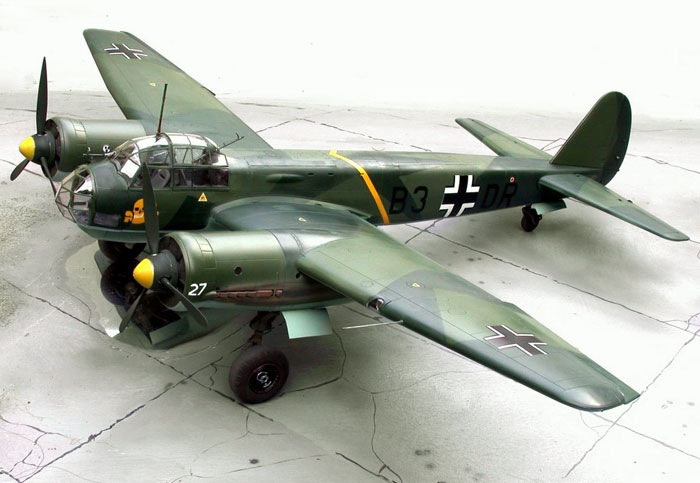 One way out of this predicament was the use of Ju 52's
captured by the Royal Air Force in Europe. In this way BEA acquired ten
Ju 52/3m in different versions. The British European Airways Junkers Ju
52/3m were in constant use until the end of 1948, before they were
scrapped at Ringway for economic reasons.
One way out of this predicament was the use of Ju 52's
captured by the Royal Air Force in Europe. In this way BEA acquired ten
Ju 52/3m in different versions. The British European Airways Junkers Ju
52/3m were in constant use until the end of 1948, before they were
scrapped at Ringway for economic reasons.
Fuselage with detailed corrugated sheet metal structure
- Detailed interior withwall cladding, luggage racks, coat hooks and ceiling lights
- Detailed passengerseats
- Two seating options may be built
- alternatively with smoking compartment
- Detailed toilet
- Oil tank above the pilots seats
- Encased undercarriage
- New exhaust system for the centre engine
- Detailed cockpit withinstrument panel and control stick
- Access door optionally open of closed
- Detailed radial engines
- Separate ailerons
- Flattened tyres
- Detailed decals for two Ju 52's with "British European Airways" markings:
- Junkers Ju 52/3m of British European Airways at Croydon; 1948
- Junkers Ju 52/3m of British European Airways at Gatwick; 1947
Colors: 9 75 78 83 84 85 89 90 91 99 301 302 314 330 363 365 371 382
On August 27th 1943, a German Luftwaffe long-range photo reconnaissance bomber, a Junkers Ju-390 took off from its base in Norway and flew out across the Atlantic Ocean. Among its four man crew was a brave and daring woman Anna Kreisling, the ‘White Wolf of the Luftwaffe’. A nickname she had acquired because of her frost blonde hair and icy blue eyes. Anna was one of the top pilots in Germany and even though she was only the co-pilot on this mission, her flying ability was crucial to its success.
The Ju-390 was twice the size of the B-29 Superfortress. It was powered by six 1,500 hp BMW radial engines and it had a range of 18,000 miles without refuelling.
This was to be the longest photo-recon mission flown by an enemy airplane in World War II. Nine hours later, the Junkers was over Canada and swinging south at an altitude of 22,000 feet. In the next few hours, it would photograph the heavy industrial plants in Michigan that were vital to the United States.

By noon on August 28th the gigantic six engined bomber was over New York City, where it finally was spotted by the US Army Air Corp. but by then it was too late. The Junkers disappeared into the vastness of the Atlantic Ocean, fourteen hours later, Anna would bring the huge bomber in to land at a Luftwaffe base outside of Paris.
Thoughts of this mission came to mind as I sat across the table from Anna Kreisling at a recent Octoberfest in Los Angeles. She is still quite beautiful with her icy blonde hair tied-back in a pony-tail and her radiant blue eyes, which have seen events in human history only a few of us could ever imagine.
She had flown Ju-52 Trimotors into the streets of Stalingrad when it had been surrounded by the Red Army. Many times her plane had been riddled with bullets so badly that she landed with only one engine running while the other two were on fire.
In 1945 she was assigned to fly the jet fighters that Germany was producing.
One of these jet fighters was the Horten V9 flying wing. It was powered by two Jumo turbo-jet engines, which enabled it to fly at 600 mph. It was armed with two 30mm cannon and air to air missiles.
Anna never scored any victories in the Horten. While taxing in the snow an American Sherman tank crew captured her after she had turned off the engine and pulling off her flight helmet they thought she was a movie star!! For the next six months she poured coffee for the US Army and did not spend one night in a POW camp. Everyone thought she was part of Bob Hope’s USO show!!
P.S. An article in Air Progress magazine in the Nov/Dec issue 1965 also talked about the Junkers Ju-390 over-flying Michigan and New York. This was held top secret throughout World War II and the Cold War.
If you look in books they will say that only two Ju-390s were built, when in fact there were around 11 built. Also they were used in Odessa, Russia to fly to Japanese held fields in China. Very secret jet engines and technology was traded for raw materials. At Area 51 in Nevada the United States Air Force it is rumored has a Junkers Ju-390 it captured during Operation Paperclip toward the end of World War II.
No comments:
Post a Comment